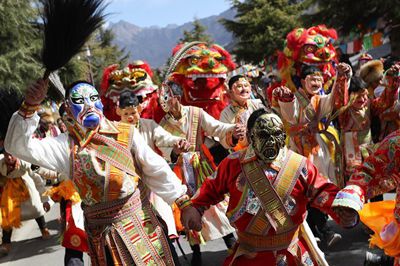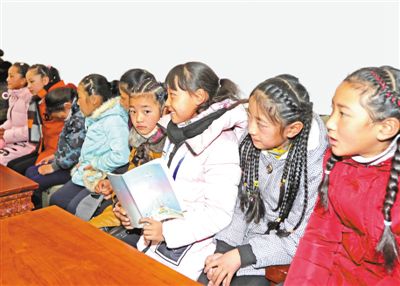se-taking, grinding mills across the agricultural areas in Tibet, water-like patterns on the walls, as well as golden roofs and round arches of monasteries. I noticed that the waist pad featuring women clothes of the Tang Dynasty was preserved in two places: Tibet and Japan. According to the legend,before the parinirvana of Sakyamuni, his disciples begged for a real image of him to point out the right way for the future generations. Upon Sakyamuni's approval, his disciples made three life-size statues of him at the age of eight, twelve, and 30, respectively. After enchanting the three statues, Sakyamuni passed away under a tree of Buddha. The Nepalese princess brought the life-size statue of eight-year-old Sakyamuni to Tubo as her dowry and Princess Wen Cheng brought the life-size statue of twelve-year-old Sakyamuni. The four statues standing in front of the principal nave were allegedly those strong men pushing the carriage for Princess Wen Cheng on her way to Tibet. When the princess and her party arrived at the Lhasa River Valley, the cart carrying the life-size statue of twelve-year-old Sakyamuni sank into sands, and the four strong men were unable to push the cart forward. Princess Wen Cheng said that it seemed that the Buddha would like to be worshipped right here. Then she had the statue wrapped up with decorative hangings. Later, Srongtsen Gampo realized Princess Wen Cheng's wish by establishing the Ramoche Monastery as the place to worship the statue of twelve-year-old Sakyamuni. After the completion of the Ramoche Monastery, Srongtsen Gampo planned to construct the Jokhang Monastery to worship the statue of eight-year-old Sakyamuni. Princess Wen Cheng practiced Han's divining and told Srongtsen Gampo that the geography of Tibet was very much like a hag, with the lake at the heart. Only by constructing monasteries in this place could the hag be foiled and Tubo be prosperous. According to books on the history of Tibet, Srongtsen Gampo took Prince Wen Cheng's advice and the lake filled. On the western wall of the grand hall of the Jokhang Monastery, there was a fresco depicting how Srongtsen Gampo led people in building the Jokhang Monastery. Standing in the southern corner of the principal nave of the Jokhang Monastery was a bluestone urn as tall as half a man. According to lamas in the monastery, the urn was left in the course of builiding the Jokhang Monastery. Small pores on the surface of the urn were said to lead to the lake. If you glued you ears to the urn, you could hear the song of wild ducks, and even moans of the hag if you were cultivated enough. I glued my ears to these small pores several times but heard nothing except the hissing sound of air. After the death of Srongtsen Gampo, the Jokhang Monastery was looted in war, and the statue of eight-year-old Sakyamuni brought by the Nepalese princ |
- Home
- News |Tibet |Exclusive |China |World |Other Tibetan-Inhabited Area |Tibet through the Eyes of Foreigners |Related News
- Documents |White Papers |Others
- Photo |Politics |Economy & Society |Culture & Religion |Human & Nature |Beautiful Tibet |Other Tibetan-Inhabited Area |Exchanges |Related
- Video |News |Documentary |Micro-Video |Entertainment
- Art
- Tourism
- In Focus
- About Tibet






